Vechain’s ‘Web3 For Better’ Whitepaper — Summarising Our Approach to Global Sustainability…
5
0
Vechain’s ‘Web3 For Better’ Whitepaper — Summarising Our Approach to Global Sustainability Challenges

The launch of our new whitepaper, co-developed with Boston Consulting Group (BCG), marks a seismic shift in the utilisation of blockchain technology in the pursuit of Environmental, Social, and corporate Governance (ESG), Sustainable Development Goals (SDG) and achieving global sustainability targets.
Titled ‘Web3 For Better’, the new whitepaper details a comprehensive approach to tackling sustainability challenges using ‘blockchain biospheres’ — ecosystems that leverage the core strengths of blockchain technology to create highly transparent, efficient and modular networks of companies and individuals to address sustainability challenges. These ecosystems deploy the approach of ‘gamification’, a concept where active engagement and participation by users is rewarded, creating powerful positive feedback loops to further incentivise sustainable actions.
Vechain has already demonstrated the efficacy and value of its technologies at scale with some of the largest global enterprises. By combining these experiences with BCG’s expertise and vast client network, we’re embarking on the next steps in our journey and globalising our successes, launching a new web3-powered era of green global development.
Below — we summarise the contents of the whitepaper to explain the core ethos and path forward in this new chapter in the mainstreaming of blockchain technology.
Redefining The Role of Web3 and Concepts of Value
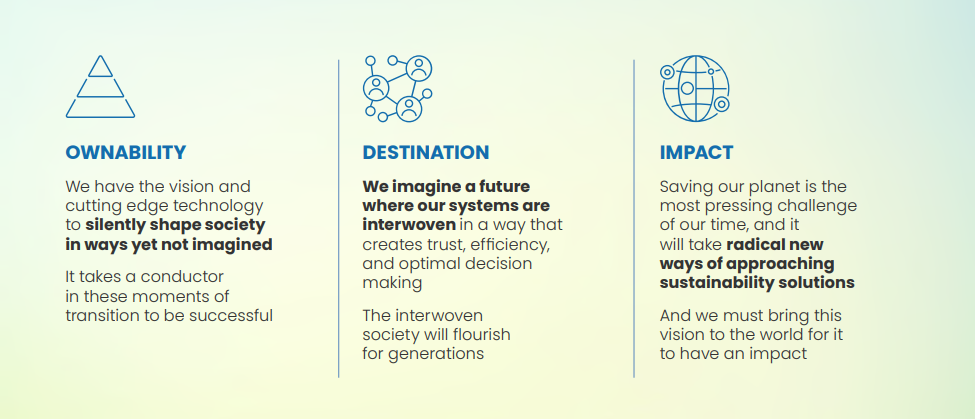
‘Web3’ is a term to describe the evolution of data ownership and the internet itself. In the current iteration — Web2 — users create or view information, submitted to, and stored by, tech providers who ultimately control information flows, leveraging these data to create value for themselves.
In Web3, we extend beyond the simple ‘read and write’ paradigm and instead, enable an environment where users can immutably create, own and fully control their data, generating value from it for the first time. Web3 also allows users to exchange value with others directly, removing the need for intermediaries. Web3 is often referred to as the ‘Internet of Value’ for this reason.

In this new epoch, the notion of value itself is shifting. Purchasing decisions such as ethics or sustainability create opportunities for consumers to drive social change through the brands and companies they engage with. These ‘positive externalities’ are overlooked in legacy valuation models and represent new opportunities to apply blockchain and create value for brands based on consumer activity.
A recent Boston Consulting Group survey of approximately 19,000 consumers found that 16% cited sustainability as one of the top-three drivers in their most recent purchase. A significantly larger share said they could be persuaded to make sustainable choices if the products or services deliver other related needs.

Put simply, social and environmental factors, or essentially, choices, create new kinds of market value that legacy models fail to take into account. It is with this framework that vechain and Boston Consulting Group are upending the traditional valuation model of goods and services by leveraging the power of blockchain to generate new economically valuable insights.
Going Green With Gamification
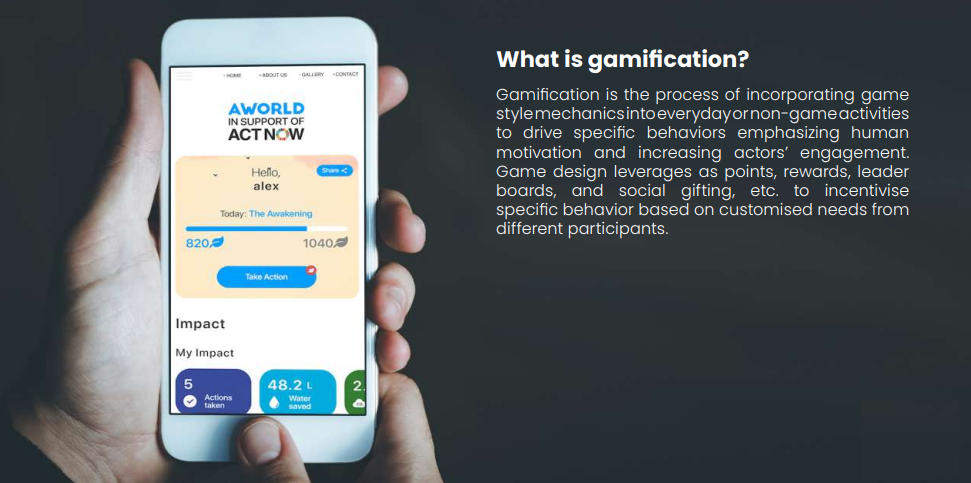
Humans are motivated by rewards and incentives. In our vision for a greener future, people are at the centre of game design — their motivations and needs shape how incentives are constructed.
For ecosystem enablers/developers, gamification enhances community engagement, generates deeper insights into consumer behaviours, increases retention and more. For participants, gamification creates community, promotes feelings of belonging, accomplishment, and ownership as well as creating tangible direct benefits such as providing discounts and services.
For example, a user journey can be created to increase second-hand fashion buyer engagement, leveraging NFTs and token-gated access. A digital product passport (tokenomics built using NFTs) can facilitate ownership transfer of a product from seller to buyer in a secure and immutable way, earning some kind of tokenized reward upon doing so.
As the buyer collects more product digital passports, their status grows and are motivated to earn extra tokens awarded in pursuit of certain milestones (e.g., their tenth purchase). Upon doing so — they gain special access to features, perhaps discounts, or certain desirable capabilities within the ecosystem (a process called ‘tokengating’).
In turn, this can be applied to create more nuanced perks across ecosystems and industries with the Blockchain Biosphere, creating new webs of engagement and multiplying the effect of individual actions..
Vechain’s ‘Blockchain Biospheres’

Vechain’s blockchain biospheres are a revolutionary approach to enabling sustainability using ecosystems of incentives and direct engagement. Blockchain biospheres are industry-spanning ecosystems dedicated to solving specific sustainability/industry needs, whether tackling sustainable approaches to global logistics trails or quantifying carbon capture and tokenizing emissions reductions of the energy sector. Early precursors of these biospheres included our Carbon Credit DApp built in 2018 with DNV and BYD, and later, becoming the tech provider for San Marino as it builds towards carbon neutrality.
For blockchain biospheres to thrive, an ecosystem’s business model must make economic sense and provide the right incentives for each actor, whether business or individual. For new ecosystems to take hold, we must also incorporate new, broader concepts of value, create a new kind of economic approach and reward/promote pro-societal and eco-friendly behaviours.
We can imagine a scenario where a reseller from a second-hand sustainable fashion ecosystem receives tokens for their efforts in promoting reuse of clothing. They can then spend those tokens for reduced fees at a charging station in the electric vehicle (EV) ecosystem. In close collaboration with Boston Consulting Group, we are in the process of expanding our enterprise partnerships and developing additional technical capabilities to support these kinds of inter-connected Biospheres.

Token holders and service providers are more motivated to contribute to and build on the ecosystems they participate in, thus growing the value of their impact, holdings and ecosystems at large. Blockchain biospheres directly incentivise participation by all kinds of users and recognise individuals, through rewards, for their activities. With these solutions, vechain is creating technical solutions to radically enhance the impact of individual actions.
Second-Hand Fashion Marketplace

One of our first examples is a second-hand marketplace ecosystem dedicated to promoting sustainable fashion. The objective is to promote the reuse and trusted after sale of clothing, reducing the environmental impact of the fashion industry while giving ecosystem participants more control over the authentication process of sales and purchases.
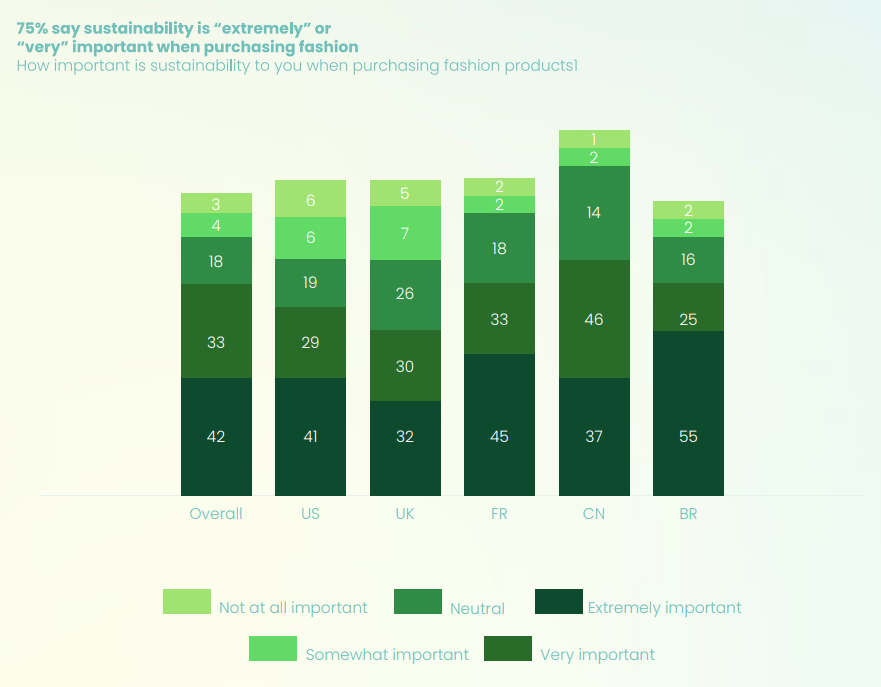
With on-chain fungible tokens, NFTs, smart contracts, and DAOs, vechain and BCG are creating greater customer engagement and stickiness. Beyond deploying digital assets, elements of Web3 can be used to roll out features that incentivise greater participation and promote loyalty, such as:
• Fungible and non-fungible tokens (e.g., spendable loyalty currencies, NFTs) to gamify interactions, track engagements with sellers and reward loyalty with real-world perks and benefits
• Utility or “Phygital” NFTs issued to reward activity in the ecosystem by unlocking early access, discounts, and unique experiences
• Deploying blockchain-based tokens to plug-in external partners and merchants. The immediate transaction settlement and interoperability rules programmed in Smart Contracts automates the manual overhead associated with such collaborations
• Token gating — aka a certain level of engagement as a requisite for access — to enable smoother collaboration between parties, and more engaging, rewarding experiences for users
• DAO-like structures to enable voting on brand decisions, such as products to launch or partnerships to bring onboard. Governance can be configured to give certain token holders’ votes more weight depending on loyalty status, history of engagement, participation in key challenges etc
The Current Strategy
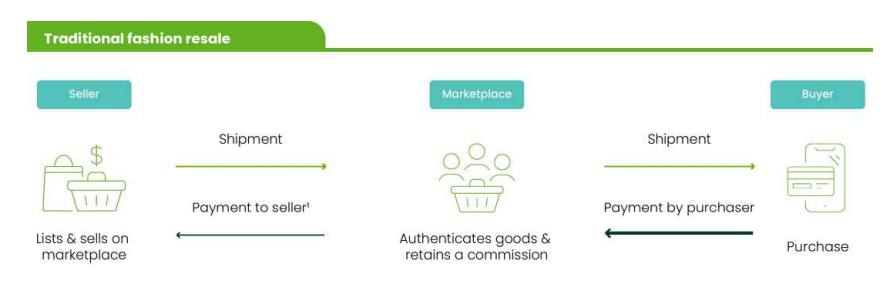
In traditional resale markets, sellers list goods on a marketplace. Higher value goods such as luxury items require authentication at physical locations, in exchange for a commission. Once purchased, goods are shipped to the buyer, who relies on the credibility of the marketplace for authentication. Payment flows from the buyer, through the marketplace, to the seller.
The Web3 Approach
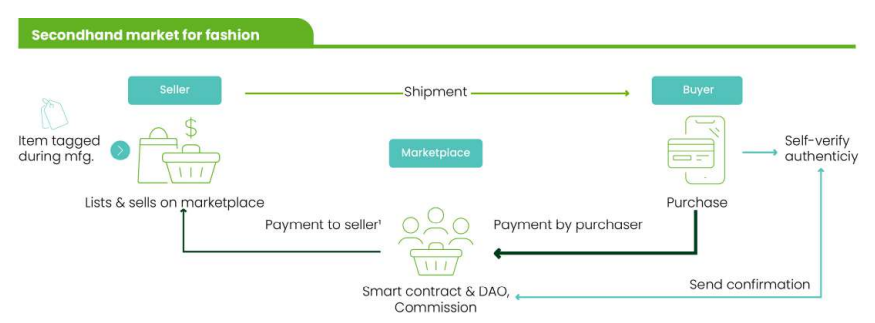
In the web3 second-hand market for fashion, sellers list goods on the marketplace. Instead of the seller shipping the goods to an authentication site, the goods are sent straight to the buyer, having already been implanted with vechain’s NFC + blockchain technologies. The buyer scans the tag to verify the authenticity of the goods themselves. Payments are executed by smart contracts and sent directly to the seller, without intermediary or commission taking.
Electric Vehicle Battery Recycling

Another key target for our blockchain biospheres are electric vehicle (EV) batteries. The objective of this ecosystem is to use blockchain technology to create battery passports, based on NFT technology, that enable full lifecycle traceability of batteries, easing the recycling process and promoting the reuse of critical materials.
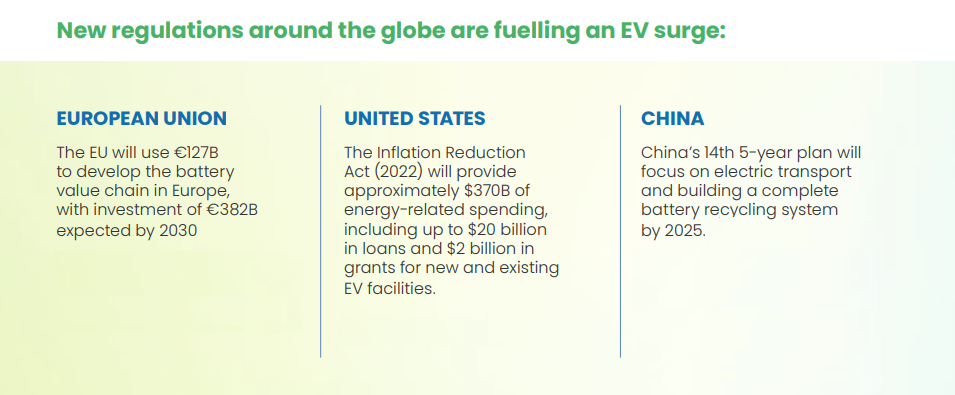
EVs are estimated to make up half of US automobile sales by 2030, according to Bloomberg. That rapid growth makes it an imperative to explore the challenges facing the sector as it continues to evolve and scale. We have identified three significant pain points for EVs and batteries:
1. High initial carbon footprint for manufacturing EVs
2. Low recycling and second life usage of EV batteries
3. Lack of engagement after initial EV sale
The European Union’s battery mandate requires that a certain percentage of a lithium-ion battery’s content come from recycled sources. A predicted shortage of the precious metals used to construct new EV batteries creates an imperative to build technical solutions to mitigate issues before they arise.
Governments are providing significant monetary incentives to build-out EV battery supply chains and recycling systems. These trends create a wealth of opportunity for vechain’s technologies.
The Current Strategy
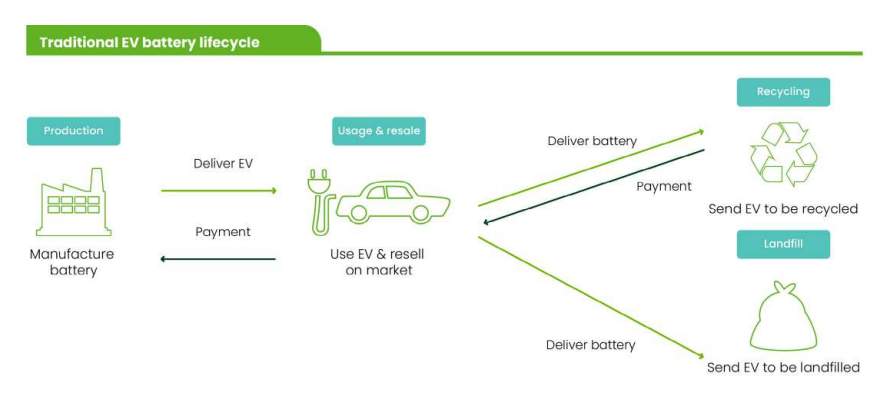
In the traditional EV battery lifecycle, there is low credibility with supply chain sustainability due to a lack of transparency. Consumers have minimal insight into the manufacturing of EVs, including their batteries. Additionally, there is a lack of traceability of batteries after the initial EV sale, either heading to landfill or recycling sites with no oversight or ability to verify.
The Web3 Approach
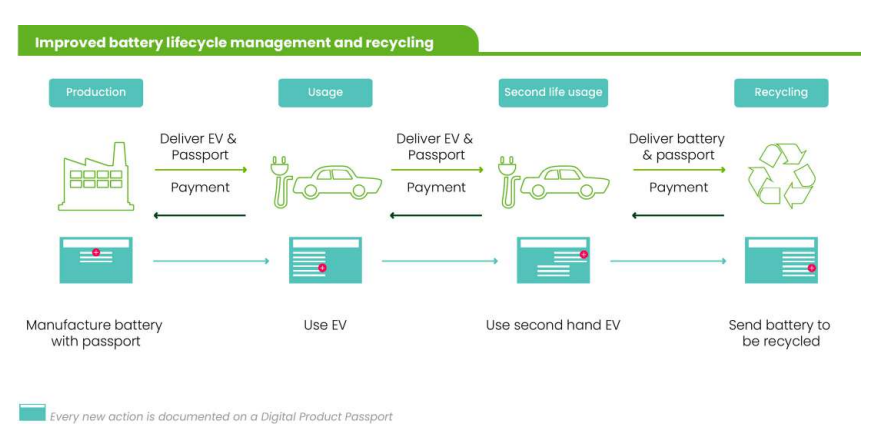
In vechain’s EV Battery Ecosystem, a phygital battery passport, powered by NFTs, becomes the enabler of sustainable behaviour. The passport collects information throughout the manufacturing process, sale process, second-hand customers, and eventually, recycling facilities, who can access the EV battery passports and retrieve battery information to complete the cycle, creating visibility across the entire lifecycle.
3D Printing and Supply Chain at the Edge (SC@E)

Our third ecosystem deploys novel technologies to tackle entrenched problems with modern supply chains. 3D printing in combination with blockchain technology is providing a powerful answer to address the sustainability challenges of the logistics industry.
Global supply chains account for 8% of annual carbon emissions, according to the International Energy Agency. The magnitude of these emissions is only projected to grow in coming decades. While this is a well-established industry, there are three significant pain points:
1. Supply chains are significant producers of carbon emissions
2. Expensive and lengthy transportation routes for spare parts from original equipment manufacturers (OEMs)
3. Unused inventory leading to waste and working capital losses
SC@E replaces traditional manufacturing with blockchain-enhanced 3D printing in a process that looks like the following:
- A customer initiates the process by placing a request for a spare part
- The request is sent to the owner of the spare part’s intellectual property who relays a digital blueprint to a 3D printing facility close to the customer
- Automobile Original Equipment Manufacturers (OEMs) send blueprint files to 3D printing facilities, securely facilitated by VechainThor
The Current Strategy

In the current supply chain and logistics industry, OEMs manufacture a spare part far away from the end user. The part may be transported hundreds or thousands of miles to the end user through a variety of transportation methods, generating significant emissions. The whole process can take days or weeks, leading to long lead times in the case of supply chain shocks.
The Web3 Approach

Supply Chain at the Edge is a more versatile and streamlined process in which the OEM is only responsible for designing the parts. When an end user has a request for a part, that part will be printed close to them after the digital file has been sent to a 3D printer via blockchain. The lead time for parts shrinks drastically, as does the emissions related to the product’s manufacturing and delivery.
The SC@E ecosystem generates three sources of value:
1) Carbon emissions savings from on-location 3D printing of physical goods, eliminating long-distance shipping
2) Time saved — 3D printing locally takes 12–24 hours and can be delivered quickly. Overseas manufacture and transportation can take weeks to reach final customers
3) Additional economic opportunities — faster supply chains allows OEMs to reduce inventory stockpiles since they can rely on on-demand 3D printing. This reduces capital costs and lets OEMs scale down inventory warehouses, increasing economic opportunity elsewhere
Vechain’s Mass Adoption: Next Gen Tooling, Integrating The System Integrators

Naturally, vechain’s technologies play a core role in the development of Blockchain Biospheres. We are building many new powerful features to enable wider scale adoption of vechain and to create technical parity with the world’s largest blockchain, Ethereum.
In the current enterprise landscape, many have opted to use private blockchains based on Ethereum technologies. With this parity, vechain will allow the seamless porting of projects to our public blockchain VechainThor.
Powerful Tools
One of the core components of this mission is our upcoming web3-as -a-service platform, VORJ.
VORJ is our most advanced toolset yet — a Web2-based portal to cater for the most demanding Web3 needs. Featuring a familiar UI, it allows users to mint, and manage fungible and non-fungible tokens, access a wide-array of smart contract templates built to Ethereum standards and a smart contract wizard for quick deployment. With this approach, we ensure seamless interoperability with other EVM networks.
We recently launched VeWorld, a powerful Web wallet, soon to be launched in mobile and desktop versions. One of the upcoming features — integration of URL-based fee delegation — means users can easily configure transaction cost payments with third parties such as vechain.energy, removing a key hurdle to mass adoption.
The wallet will feature innovative functions such as a fiat on/off ramp, token bridges, a native DEX, a native NFT viewer and more.
Other key technical features include the deployment of a carbon footprint explorer via VechainStats, an official sustainability-focused NFT marketplace, oracle integration to bridge data from the real world and other blockchains, greatly enhancing cross-chain operability and a DAO development framework.
We have been dedicating significant resources to improving developer tooling, including contract development framework integration, a contract development IDE, the OpenZeppelin smart contract library, Ethereum’s Hard Hat and Truffle toolsets and more.
Integrating The System Integrators
A key adoption vector for vechain is through the various global system integrators — a dedicated team is now focused on working with various global ERPs to offer vechain-as-a-service, leveraging our powerful VORJ platform.
Through this approach, the VechainThor blockchain is obtaining global accessibility at a far greater scale than before. This approach, in tandem with the extensive networks of our strategic partners is placing vechain at the core of enterprise blockchain development, and promises to see our blockchain thrive as a core player in the web3 era.
Next Steps
Launching and establishing the first ecosystems is now our core priority. With our tool sets almost live, we are coordinating something grander in collaboration with our strategic partners.
We are identifying players who fit the roles needed for each sustainability ecosystem to operate and who understand the necessary incentives for stakeholders to participate. Our differentiated underlying technologies and portfolio of real-world applications (co-developed through enterprise partnerships) are providing a springboard for vechain to become the enabler of Web3 at scale, and empower people to drive positive change.
Closing Remarks
The Blockchain Biosphere approach represents the foundational layer of the next decade of blockchain development. These interconnected ecosystems finally offer individuals the platform to drive meaningful outcomes, at scale.
Web3 technologies distribute power among the many instead of concentrating it among the few. Through our promotion of continuous research and innovation, in partnership with academic institutions, developers, and strategic partners, vechain is advancing Web3 in its entirety, powering practical and efficient solutions to address real-world challenges.
With new governance and economic models that will cater for smooth and scalable adoption of vechain’s blockchain, our Biosphere represents a significant moment in the history of this emerging industry.
Join us, and let’s build the future of sustainability, together.

About vechain
Vechain, headquartered in San Marino, Europe, is the curator of VechainThor, a world leading smart contract platform spearheading the real world adoption of blockchain technology.
Through leveraging the capabilities of ‘trustless’ data (information without intermediaries), smart contracts and IoT technologies, VechainThor has enabled solutions across a wide array of fields. Vechain now turns its attention to the greatest challenge of all — building digital ecosystems to drive sustainability and digital transformation at global scale.
Visit https://www.vechain.org to learn more.
5
0
 Manage all your crypto, NFT and DeFi from one place
Manage all your crypto, NFT and DeFi from one placeSecurely connect the portfolio you’re using to start.





